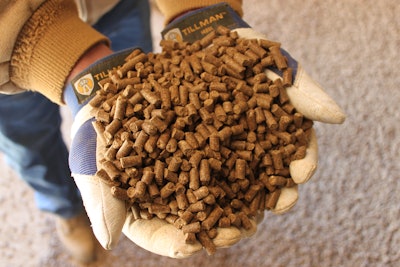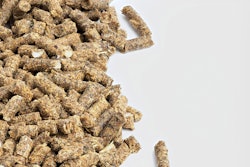
Pellet quality includes more than durability index, but in commercial practice, it is durability that determines pellet quality.
Quality pellets are produced by using a good piece of machinery and trained personnel. I have seen expert pellet machine operators perform miracles with the oldest possible equipment.
Ideally, trained personnel and new equipment are readily available. If not, the nutritionist who formulates the feed should be involved to ensure pellet durability is not compromised.
Seven tips for durable pellets
Here are seven ideas I use to ensure my pellets always come the way I want them – durable yet soft, so both the buyer (human) and user (animal) are happy.
1. Add wheat or wheat gluten
It is no secret that gluten (a wheat-specific protein) enhances pellet durability as it acts like a glue. Adding 10% wheat will improve durability, while adding more will increase it even further. Wheat, however, is not always available or inexpensive.
If feed cost is not an issue, then adding 1% to 2% wheat gluten can help. Such feeds include diets for piglets and very young broilers. The protein in barley and other cereals does not have similar protein properties as those found in wheat gluten protein.
2. Control the level of molasses
Molasses is a viscous material that enhances palatability as it is rich in sugars. It also helps to lubricate the die to avoid excess heat friction during pellet expression.
A small amount of molasses (1% to 2%) will help produce a more durable pellet as it forms Maillard reaction products on the surface of the pellets.
Adding too much will produce soft pellets that break apart easily – animals love these high-molasses pellets, but there are too many fines produced.
3. Limit the amount of oil – preferring animal fats
Like molasses, oils will act as lubricants but without the binding effect. Adding high levels of oils will produce soft pellets.
If high-energy feeds must be produced in pellet form, it is best to use animal fats that will not be liquid at room temperature.
On the other hand, young animals digest vegetable oils better than animal fats, so there is a trade-off between pellet quality and animal performance. Nevertheless, adding lipids in general tends to produce softer pellets.
4. Reduce the amount of fiber
A small amount of crude fiber is needed for a durable pellet as fiber creates a structure like armored cement. Visualize it as an entanglement of all ingredients in a matrix, especially when sticky molasses is present.
Adding too much fiber, especially from any source that is not finely ground, however, will cause pellets to crack at weak points producing crumbles. Sometimes this might be the desired effect, but these are broken pellets and not real crumbles that are produced after pelleting by a pellet crumbling machine.
5. Account for particle size of all major ingredients
If normal soybean meal is about 900 microns, then it will bind well into a durable pellet with corn or other cereals that are ground to a similar particle size.
In contrast, finely ground corn (less than 500 microns as preferred for piglets) or coarsely ground corn (above 1,500 microns) will produce pellets of questionable structural integrity.
When considering switching from soybean meal to another protein source, consider the particle size of the new ingredient. Sometimes formulating very-low soybean meal diets causes pellets to be friable as there is not enough protein to bind the different molecules in the matrix created by fiber.
6. Add animal by-products
Where allowed, and if they price in favorably during formulation, blood products, including animal plasma, are known to increase pellet durability. In fact, the bonding properties of blood products are known and used in other industries, too.
In general, animal-derived byproducts are good pellet binders, especially if they contain high levels of collagen (another protein with sticky-binding properties).
Some animal products might contain excessive levels of soft fat (such as chicken fat). This might not help in producing the best pellet possible.
7. Add milk products
Whey protein concentrate is known to be an extremely strong pellet binder as well as a choice ingredient for piglet feeds. Adding more than 10% whey protein concentrate will produce pellets that are not only durable but hard to chew by newly weaned pigs.
In general, all milk products that contain protein increase pellet durability. In contrast, milk ingredients rich in lactose but poor in protein (for example, whey or permeate) tend to produce rather friable pellets.
Each feed ingredient has different durability effect
In general, it can be said that proteins and fiber, when used in balance, can increase pellet quality in terms of durability.
In contrast, starches, lipids, and sugars have the opposite effect, with a few notable examples, when used appropriately.
Each ingredient has a different effect on pellet durability, and it is best to discuss this issue with experienced feed mill personnel, especially when considering alternative ingredients.
For example, cassava (tapioca) is known to produce very low-quality pellets as its starch is not “pasty” enough. Finely ground sorghum, however, will produce the opposite effect as its starch is too pasty.
Ingredient impacts on animal performance
Remember, what humans consider “good” pellets are not necessarily what animals prefer.
Picking ingredients only on their merit regarding pellet durability may have adverse effects on animal performance. As mentioned before, too-strong pellets will prevent young piglets from being able to chew them, reducing their feed intake.
In contrast, poultry and rabbits prefer strong, durable pellets. Piglets benefit from finely ground cereals, but the opposite is true for young broilers.
Why continued education is important
Unfortunately, feed manufacturing is not a course taught at the undergraduate college level. Even at higher education levels, not many universities, even in the U.S., have enough expertise to offer such opportunities to their students.
Luckily, in the past decade, the importance of educating animal nutrition graduate students on feed manufacturing practical aspects has been recognized. The success of Kansas State University (KSU) has been emulated in many other universities.
I was fortunate enough that Dr. Hancock, my MSc mentor at KSU, suggested I take classes at the Grain Science department where I was taught about feed manufacturing by legends such as Drs. Benhke and Fairchild.
Such knowledge continues to assist me in everything I do, and I highly recommend new students seek out such courses, even if it is only online.


















